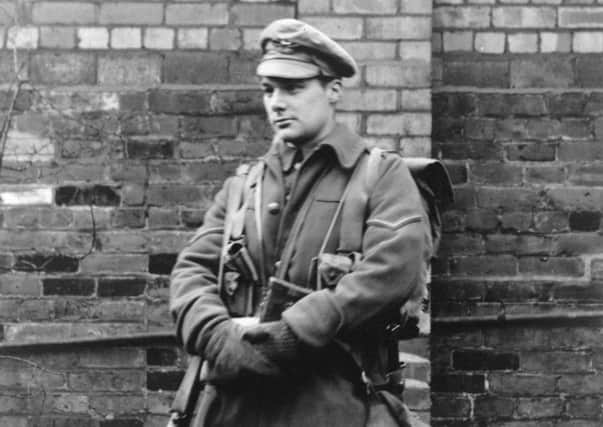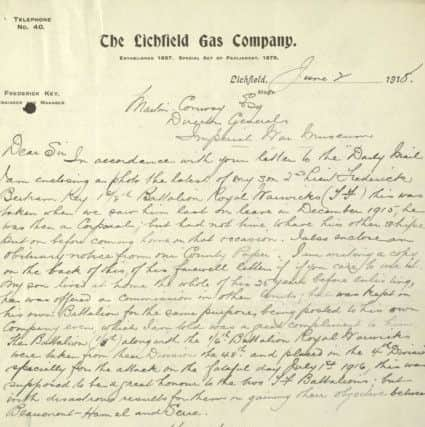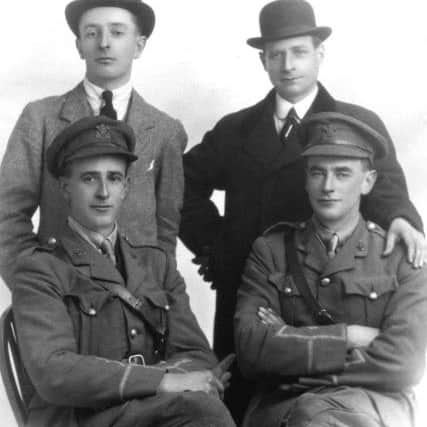Families' memoirs commemorating Somme veterans released


The Imperial War Museums (IWM) has revealed documents and pictures commemorating soldiers - including Second Lieutenant Frederick Bertram Key from South Yorkshire - who lost their lives in the Battle of the Somme in 1916, the bloodiest clash in the First World War.
The documents originally formed part of the IWM’s Bond of Sacrifice collection, dating back to the museum’s foundation in 1917, and will now be part of the Lives of the First World War digital memorial to those who took part in the conflict.
Advertisement
Hide AdAdvertisement
Hide AdAdvertisements in newspapers from September 1917 until April 1920 asked people to contribute photographs and biographies of their loved ones who had died in the war, and hundreds responded.


Contributions the IWM received from families of those killed on the Somme include a photograph of two brothers thought to have died in each other’s arms and a farewell letter written by a soldier who died on the first day of the battle.
They also include letters from soldiers’ comrades and memoirs written by parents about their children.
Charlotte Czyzyk, project manager for Lives of the First World War, said: “These powerful photographs and letters were donated to IWM by families in tribute to their loved ones who were lost in the bloodshed of the Battle of the Somme.
Advertisement
Hide AdAdvertisement
Hide Ad“Now, for the first time through IWM’s Lives of the First World War, we can share these poignant stories online and ensure that these men are remembered 100 years on.”


A farewell letter from Frederick Key, who was from Ecclesall Bierlow, Sheffield, was donated by his father, along with a portrait taken when he was on leave in December 1915.
The letter written on the eve of the Somme, the day before he died, said that “if you receive this you will know that I have unfortunately been ‘bowled out’ middle peg, however you may be sure I battled well”.
He also wrote that “if some have to die and if I am one, well I can’t grumble, I have had 26 years of a quiet, easy life, I certainly ought to have spent it better, but we all say that”.
Advertisement
Hide AdAdvertisement
Hide AdCardiff-born Second Lieutenant Leonard Tregaskis and his brother Lieutenant Arthur Tregaskis were both killed in Mametz Wood, on July 7 1916 and it is said they were within 50 metres of each other when one was wounded and the other rushed to his aid and was shot.


They died in each other’s arms and their mother received one telegram in the morning informing her of one son’s death, and later the same day, another telegram telling her the other son had died.
Their father sent the IWM a photograph of his sons and information including comments from Major Smith OC of the 16th Battalion Welsh Regiment, who said: “They were both among the noblest and bravest of our valiant officers. I always found them true hearted men. The whole Battalion regarded them with deep affection and real pride.”
Another soldier who died on the Somme on July 1, 1916 was Lieutenant John Woodall Marshall, who received the Military Cross for his service in the First World War.
Advertisement
Hide AdAdvertisement
Hide AdIn her letter to the IWM, his mother said that his lieutenant colonel had written: “I had the highest opinion of his bravery and capability and he will be a great loss to me and the battalion.”


Private Archie Brammer was also killed on the first day of the battle and his father sent the IWM a photograph, a biography and a letter from friend and comrade Albert Gutrum, who said he did not know what had happened to Archie in the battle.
“Trusting you will find comfort in his brave sacrifice for his country and more so in his good life in the best of his religious principles,” Albert wrote.